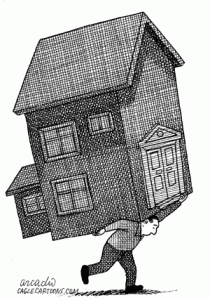Government Determined To Keep Unwilling Homeowners In Homes
The FDIC announced a new initiative to reduce foreclosures on home mortgage loans held by failed banks that were acquired by another institution. This new FDIC program goes far beyond previous government mortgage assistance programs such as the Home Affordable Refinance Program (HARP) and the Home Affordable Modification Program (HAMP).
Whereas the HARP and HAMP programs require income verification and attempt to lower a monthly mortgage payment to a level that is reasonable in relationship to a homeowner’s income, the new FDIC forbearance plan will attempt to help homeowners who are currently unemployed.
FDIC Encourages Forbearance To Unemployed
As part of its loss-share agreement with acquirers of failed FDIC-insured institutions, the FDIC is encouraging its loss-share partner institutions to consider temporarily reducing mortgage payments for borrowers who are unemployed or underemployed. This program will provide additional foreclosure prevention alternatives to these borrowers through forbearance agreements that will give them an opportunity to regain full employment and avoid an unnecessary foreclosure.
“With more Americans suffering through unemployment or cuts in their paychecks, we believe it is crucial to offer a helping hand to avoid unnecessary and costly foreclosures. This is simply good business since foreclosure rarely benefits lenders and would cost the FDIC more money, not less,” said FDIC Chairman Sheila C. Bair. “This is a win-win for the borrower, who can remain in his or her home while looking for a new job, and the acquiring institution, which continues to receive payments on the loan. Ultimately, by reducing losses under our loss-share agreements, this approach helps reduce losses to the FDIC as well.”
The recommendation to loss-share partners applies where unemployment, or underemployment, is the primary cause for default on a home mortgage. In such cases, the FDIC is urging its loss-share partners to consider the borrower for a temporary forbearance plan, reducing the loan payment to an affordable level for at least six months. The monthly payment during this period should be established based on an affordable payment – given the borrower’s circumstances – and it should allow for reasonable living expenses after payment of mortgage-related expenses.
FDIC Plan Likely To Help Few Homeowners
The objectives of the FDIC’s forbearance plan are well intentioned. Allowing an out of work homeowner time to find a new job may prevent an unnecessary foreclosure and eliminate the need for a costly foreclosure by the bank. From a practical standpoint, the FDIC plan may ultimately benefit very few homeowners for the following reasons:
- The program is only available to those homeowners who have mortgages with failed banks that were acquired by another institution under a loss-share agreement with the FDIC.
- Under the forbearance agreement, the bank will accept only a portion of the regular mortgage payment. The FDIC is asking for only a 6 month forbearance. Given the prospects of a “jobless economic recovery” and the difficulty in finding new employment, the FDIC appears wildly optimistic about a quick change in fortune for an unemployed homeowner. Banks do not want to foreclose, but very few banks now offer a forbearance plan to the unemployed since they do not expect them to quickly find a new job.
- The mortgage foreclosure prevention plans currently in effect have had dismal success rates and these programs are limited to candidates who have income. The HARP program, expected to help millions of homeowners had at the end of July approved only 60,000 refinances. The government loan modification program (for those not qualified under HARP) has been plagued by very high re default rates ranging from 17% to 45%.
- The FDIC recommends that the lender establish an “affordable payment” for six months, allowing for reasonable living expenses. Many homeowners with jobs are struggling to make their mortgage payments. Many states pay only a fraction of previous earnings in unemployment benefits. Unless the homeowner has put aside some savings, unemployment compensation will usually cover only basic needs, leaving nothing for a mortgage payment. It is likely that any payment (other than zero) will be too high for unemployed homeowners.
- Recent statistics on the “cure rate” for delinquent mortgages show a stunning decline. The cure rate is the percentage of borrowers who are able to catch up and bring a delinquent mortgage current again. As of July, the cure rate for prime mortgage loans plummeted to 6.6% from an average of 45% during 2000 to 2006. Some of the delinquent borrowers had lost their jobs but many were still employed. This is a sea change in attitudes towards home ownership. Many of those financially able to catch up apparently saw no benefit in doing so; either the burden of home ownership outweighed the benefits or there was no perceived benefit in continuing to make payments on a home with large negative equity. Many homeowners may view foreclosure as the best “program” for getting back on their feet since they could potentially enjoy years of “rent free” housing before the bank ultimately forecloses.
Trapped Homeowners Want Out
Courtesy: laprogressive
Many Americans are apparently rethinking the “dream” of home ownership and acting accordingly by relieving themselves of the costly burden of mortgage payments, taxes and maintenance on what has become a depreciating asset.
While the government says “yes we can”, impoverished homeowners are saying “no we can’t”. Perhaps this is why the massive government initiatives to prevent foreclosures are failing. Trapped homeowners are doing what’s best for them and walking away, while the government vainly attempts to impose home ownership on those who now reject it.
